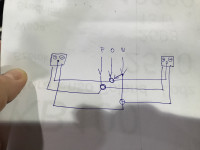Hello
I don't want to start a new topic and I have a quick question if I can connect my 2 different sockets in this way, my main cable probably has no grounding and I don't even know where it is connected, so I immediately thought to make a bridge on this main cable and not to do it on the sockets bridge
I don't want to start a new topic and I have a quick question if I can connect my 2 different sockets in this way, my main cable probably has no grounding and I don't even know where it is connected, so I immediately thought to make a bridge on this main cable and not to do it on the sockets bridge
Moderated By krzysiek7:Separated from the topic https://www.elektroda.pl/rtvforum/topic2257479.html




